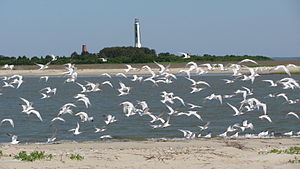Cape Romain National Wildlife Refuge
| Cape Romain National Wildlife Refuge | |
|---|---|
|
IUCN category Ib (wilderness area)
|
|
 |
|
| Location | Charleston County, South Carolina, United States |
| Nearest city | Awendaw |
| Coordinates | 32°59′33″N 79°33′50″W / 32.99250°N 79.56389°WCoordinates: 32°59′33″N 79°33′50″W / 32.99250°N 79.56389°W |
| Area | 66,287 acres (26,825 ha) |
| Established | 1932 |
| Visitors | 154,000 (in 2010) |
| Governing body | U.S. Fish and Wildlife Service |
| Website | Cape Romain National Wildlife Refuge |
The Cape Romain National Wildlife Refuge is a 66,287 acre (267 km²) National Wildlife Refuge in southeastern South Carolina near Awendaw, South Carolina. The refuge lands and waters encompass water impoundments, creeks and bays, emergent salt marsh and barrier islands. 29,000 acres (120 km2) are designated as Class I Wilderness. Most of the refuge is only accessible by boat. Mainland facilities include the refuge's headquarters and visitor center which are located on U.S. Highway 17 about 30 minutes by car from Charleston, South Carolina.
In the 1800s the red wolf was abundant in the Southeastern United States including South Carolina. However, by the mid-1960s, efforts of trappers, hunters, and farmers— combined with the destruction of natural habitat— nearly wiped out the population. Only a few wolves remained in Texas and Louisiana. To protect the red wolf, they were taken into captivity, and by 1980, were extinct in the wild. Within the decade, captors of the red wolf were looking to reestablish the red wolf's territory. In 1987, red wolves were released in Alligator River National Wildlife Refuge in eastern North Carolina, Bull Island in South Carolina, Horn Island in Mississippi, and St. Vincent Island in Florida.
Established in 1932 as a haven for migratory birds, Cape Romain National Wildlife Refuge is additionally managed for the protection of threatened and endangered species such as the loggerhead sea turtle, wood stork, and piping plover. Every year loggerhead sea turtles bury their eggs on three of the refuge's barrier islands. The refuge supports approximately 23% of the northern subpopulation of loggerhead sea turtles, the largest north of Florida. For the past 30 years refuge employees have helped loggerhead turtles survive by identifying nests that are in areas subject to overwash and inundation, and moving them to a safer area on the island.
...
Wikipedia

